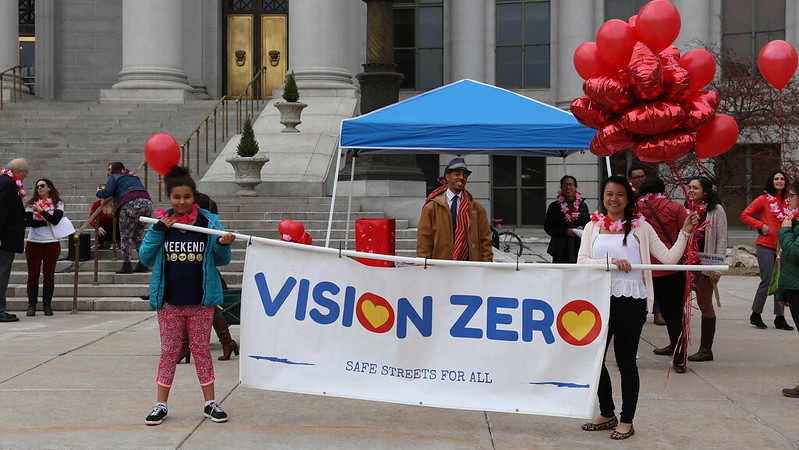Vision Zero
We advocate so that no one dies or suffers serious injuries just trying to get around Denver. Traffic deaths are preventable and unacceptable.
Read our blog post, How Denver can meet the moment with Vision Zero.

What is Vision Zero?
Vision Zero is a strategy for eliminating traffic fatalities through a systems approach, rather than placing all the responsibility on individuals to keep themselves safe. People will sometimes make mistakes, so our streets and related policies should be designed to ensure those inevitable mistakes do not result in tragedy. Read Denver’s recently updated Vision Zero Action Action Plan to learn more.
Why does it matter?
Traffic fatalities are one of the leading causes of preventable death in the U.S., along with gun violence and drug overdoses. Fatalities are going up in Denver and across the U.S., reaching a recent high of more than 80 deaths per year on our city streets. Pedestrian deaths are increasing at the fastest rate, and people of color and those living in lower-income areas are the most likely to be killed while walking.
What’s the problem, and what can be done?
The reasons why traffic deaths are going up are pretty clear: There are too many cars and trucks that are too heavy and tall, driving too fast on streets that are too wide, with too many points of conflict. Click on the links below to learn more about each of these problems, and the solutions we can pursue to make our streets safer for everyone.
Too many cars and trucks
Ninety-nine percent of fatal crashes in Denver involve a person driving a motor vehicle. Simply put, driving around in personal vehicles that weigh thousands of pounds and travel at high rates of speed is the most dangerous way for people to move through urban areas. The fewer cars and trucks that are on our city streets, the fewer opportunities there are for crashes that result in serious injuries or fatalities.
Solution: Investments in transit
A key theme of Denver’s recently updated Vision Zero Action Plan is “Focus on shifting modes away from driving by building out the transit network.” Read more about the potential for transit investments to dramatically increase safety on our city streets in our 2022 Vision Zero Call to Action: The Way to Zero Traffic Deaths is on the Bus.
Cars and trucks are too heavy and too tall
More than 80% of US car sales are now trucks and SUVs, and these vehicles keep getting bigger. For example, the Ford F-150 is now about 800 pounds heavier and 7 inches taller than it was in 1991. Electric vehicles often weigh even more due to huge batteries. These taller, heavier vehicles are much more lethal for pedestrians. Tall vehicles have bigger blind spots and are more likely to strike a person’s torso or head. Heavier vehicles exert more force crashing into a person, bicycle, or smaller car. They also have longer braking distances.
Solution: Weight-based fees and stronger regulations on vehicle design
We join with advocates across the country in calling on the Federal government to update vehicle design and safety standards to protect people on foot, on bikes, and using mobility devices from the increasing threat of large vehicles. We also supported proposed state legislation that would increase registration fees for larger vehicles and use the revenues to fund safety improvements for people walking, biking, and other vulnerable road users.
Cars and trucks are too fast
Speed is a primary factor that determines whether a traffic crash happens, and whether the crash results in a serious injury or fatality: the likelihood of death increases dramatically when vehicle speeds exceed 20 mph. Higher speeds increase a driver’s reaction time and braking distance, and reduce the driver’s field of vision.
Solution: Safe street designs and lower speed limits, paired with equitable automated enforcement
The best way to reinforce safe speeds is through street design, which is why we advocated for the adoption of Denver’s new Complete Streets Design Guidelines, which includes a whole new suite of “traffic calming” treatments that help reduce speeds such as speed humps and mini traffic circles, and we are pushing for widespread implementation of these designs throughout the city. We also successfully advocated for Denver to reduce the default speed limit, which applies primarily to neighborhood streets, from 25 to 20 mph, and are pushing for speed limit reductions on other streets as well. These lower limits further justify implementation of traffic calming treatments. Finally, we are calling on the City to increase the equitable use of automated speed enforcement, another proven strategy for reducing speeding and crashes.
Streets are too wide, with too many points of conflict
Decades of planning our streets to cater to the efficient and rapid movement of cars, trucks, and other motorized vehicles has negatively impacted the ability to travel safely through our city. Many of the most dangerous streets in our city, like Colfax Avenue and Federal Boulevard, are designed like highways, often six or more lanes wide. These wide streets encourage high vehicular speeds, and the lack of basic accommodations for people walking, rolling, biking, and accessing transit creates dangerous conflicts among road users.
Solution: Transformation of urban arterials from deadly highways to people-friendly main streets
Denver’s highway-style urban arterials are currently the most dangerous streets in our city, and are also home to many of the destinations that Denverites are trying to reach every day, including a plethora of cherished, locally owned businesses that reflect the rich cultural diversity of the surrounding neighborhoods. To achieve their full potential as people-friendly main streets and be truly safe for everyone, these corridors must be fundamentally transformed. This means reducing the number and width of vehicular travel lanes, and adding dedicated space for sidewalks, bike lanes, and transit so that more people can get around more easily without driving. Read more about how transit is at the heart of this needed transformation in our 2022 Vision Zero Call to Action: The Way to Zero Traffic Deaths is on the Bus.

Cole’s Story
On July 13, 2016, Cole Sukle and his two best buddies were enjoying a sunny summer day, riding skateboards through their neighborhood, when they stopped to cross Yale Boulevard on their way to the middle school basketball court nearby. Standing safely within the bike lane, one of the boys looked to his left, barely processing the speeding car already upon them and too late to do anything more than jump back. The boy watched helplessly as the speeding drunk driver hit his two friends and drove away. Miraculously, two of the boys escaped the crash unharmed, but Cole was rushed to Denver Health where he died the next day.
When the City of Denver asked Cole’s family if they’d be willing to share his story as part of the announcement of a new plan to eliminate traffic fatalities in Denver, they were honored to oblige. Like most people, the Sukles didn’t know much about what made streets safe or unsafe. They taught their kids to look both ways, stay on the sidewalk and always use the crosswalk. But the Vision Zero Action Plan that Cole’s story helped announce opened their eyes to the ways cities can either design streets and neighborhoods to be safe for people walking and biking, or cater to cars, leaving streets deadly and dangerous.
Cole’s story is just one of hundreds that inspires the Denver Streets Partnership to consistently hold the City accountable to its commitment to eliminate traffic fatalities and serious injuries by the year 2030.
Related Resources
CDOT’s Safer Main Streets aims to make streets safer for people walking, biking, and driving
Denver Streets Partnership chair Danny Katz is excited that CDOT will invest more than $7.4 million on Federal Boulevard and $10 million on West Colfax to improve streets for people walking, biking, and riding transit.
CDOT Is Trying To Fix Metro Denver’s Most Dangerous Roads
CDOT announced funding for Safer Main Streets projects on Colfax and Federal, and Denver Streets Partnership chair Danny Katz talked to Colorado Public Radio about it.
Uniting to Stop Preventable Traffic Violence
VISION ZERO NETWORK: During the week of November 15th – 21st, Denver Department of Transportation & Infrastructure and Denver Streets Partnership hosted a virtual Facebook event to honor victims of traffic crashes and their families, and reaffirm our commitment to the fundamental principles of Vision Zero and making our streets safer for everyone, together.
48 people killed while walking, rolling, biking and driving around Denver this year get a COVID-style memorial
DENVERITE – So far in 2020, 48 people have been killed trying to travel around Denver, according to the Denver Police Department. The numbers are bad each and every year, especially if you recognize, as the city government officially does under the banner of Vision Zero, that one traffic death is too many. Each year, advocates for […]
Denver’s next fire chief must embrace Vision Zero
Street design plays a central role in ensuring the safety of all road users. Denver’s next fire chief must embrace Vision Zero.
Footwear display in Denver is solemn reminder of pedestrians killed by autos
Denver Post – Seventy-six pairs of footwear, representing 76 pedestrians killed by motor vehicles in Colorado in 2019, were displayed side by side Tuesday in Denver to honor the dead and remind drivers to be cautious and vigilant. CDOT joined Denver Streets Partnership in sponsoring the display Tuesday at Union Station. A billboard campaign is […]
‘Left Behind’ Shoes Campaign Spotlights Pedestrians Killed
DENVER (CBS4)– The Colorado Department of Transportation is trying to spotlight the number of pedestrians killed in vehicle accidents with shoes. The Left Behind campaign draws attention to the 76 people who died while walking on Colorado streets last year. CDOT also partnered with Denver Streets Partnership to display 76 pairs of shoes at Union […]
CDOT remembers pedestrians killed with display of 76 shoes
DENVER — The Colorado Department of Transportation (CDOT) is remembering the 76 pedestrians who lost their lives in Colorado in 2019 with a new pedestrian safety campaign. “Streets connect us and can foster health, happiness and opportunity, but only if they are safe places for everyone,” said Jill Locantore, executive director of Denver Streets Partnership. […]
CDOT launches ‘Left Behind’ campaign to reduce pedestrian deaths
The Colorado Department of Transportation and Denver Streets Partnership joined this week to remember the 76 pedestrians who lost their lives in 2019, while also reminding drivers to use caution near pedestrians on Colorado roads.
Letter to DRCOG regarding Regional Vision Zero Action Plan
Bicycle Colorado and the Denver Streets Partnership recently shared comments on DRCOG’s Regional Vision Zero Action Plan. We are thrilled about the impact this Vision Zero Action Plan will have across the region by supporting communities in prioritizing people and safer roadways. We were also excited to learn that the plan will be used very soon […]
People behind the Progress: Talking with Jill Locantore of the Denver Streets Partnership
March 30, 2020 — For this month’s People Behind the Progress, we’re talking with Jill Locantore, the Executive Director of the Denver Streets Partnership and a leader in Denver’s Vision Zero movement. In our conversation we’ll talk about the work of the Denver Streets Partnership – ranging from pop-up traffic calming pilot projects as a […]
Survey: Denver voters support bike lanes, Vision Zero (CO Politics)
Denver – A survey of 500 Denver voters found that four in five people support the city’s plan to add 125 miles of bicycle lanes by 2024, with majorities even agreeing that bike infrastructure should come at the expense of parking and travel lanes. “Increasing mobility options in Denver is a non-partisan issue that crosses […]
